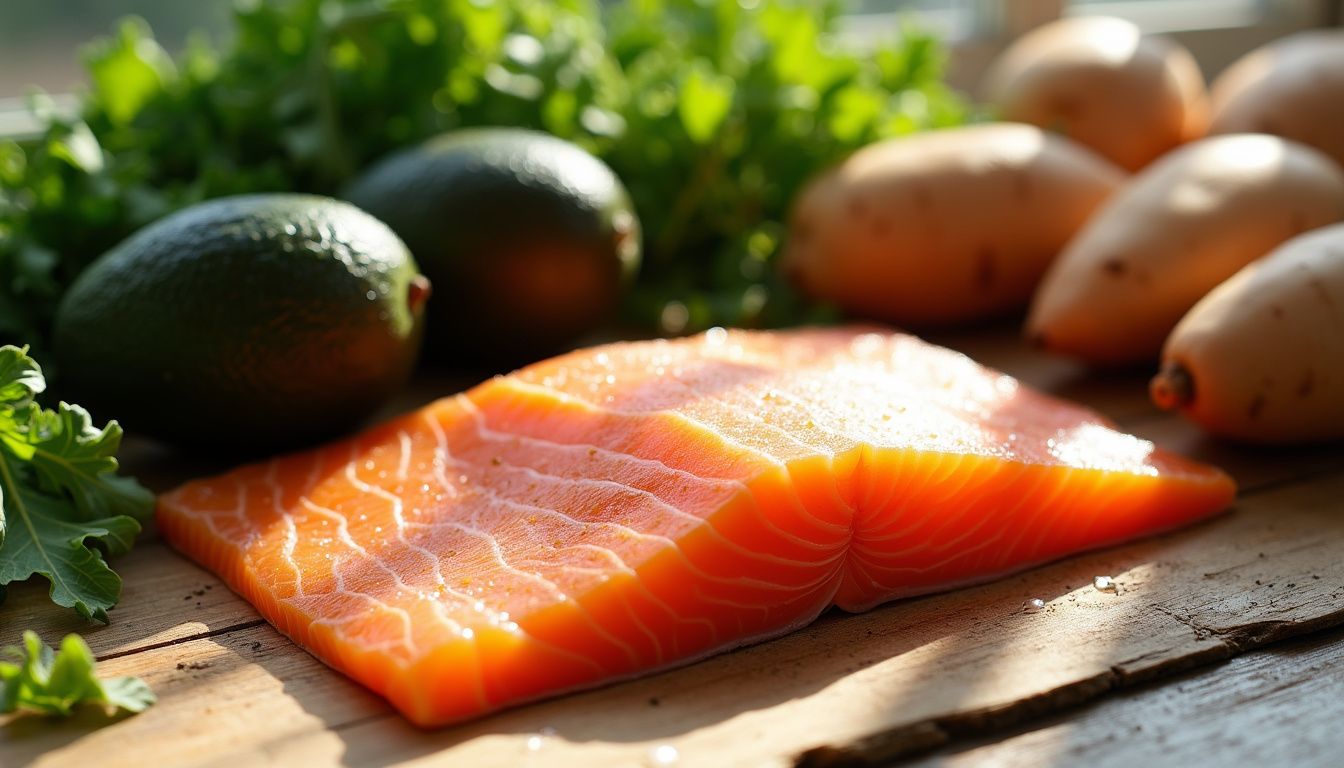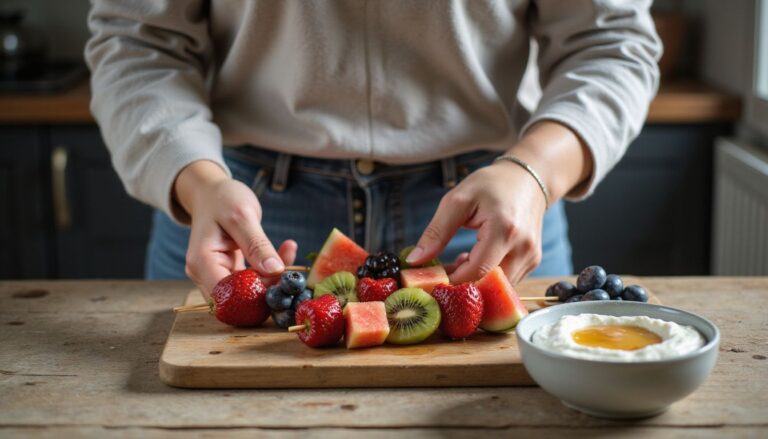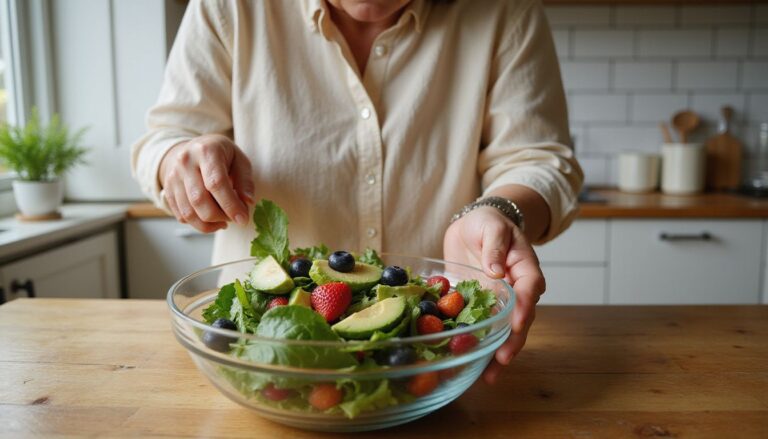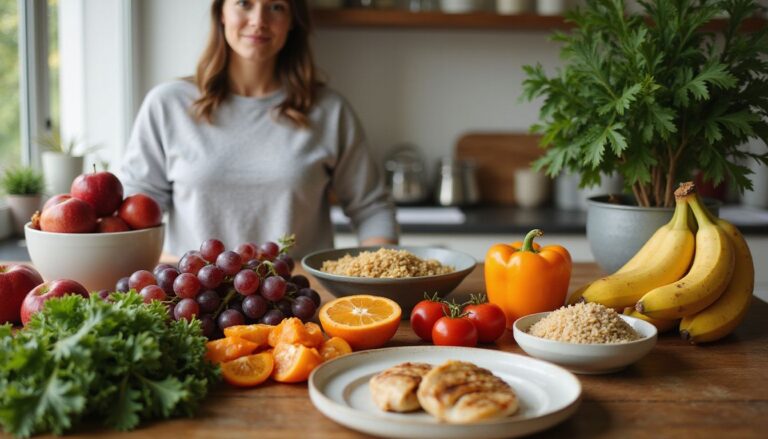Top 10 Best Meals For Weight Loss: Lose Weight With The Best Foods
Our Nutrition Assistant AI Suite will transform your body. You will lose fat, get toned, and build muscle. Gain confidence and optimal health.
You might feel stuck trying to lose weight while keeping meals satisfying. Small swaps, like pairing avocado with leafy greens or salmon with sweet potato, can support steady weight loss and better health.
This guide gives you simple recipes, smart meal ideas, and clear tips on choosing the best meals for weight loss. You will learn which healthy foods help you feel full and reach your goals faster. Keep reading for easy ways to make healthy eating work in your day.
Key Takeaways
- Meals high in protein and fiber, such as chicken breast and beans, help control hunger and reduce overeating by keeping you full longer.
- Broth-based vegetable soup before lunch can lower calorie intake at the meal by 20%, according to a 2007 study published in Appetite.[1]
- Foods low in calories but rich in nutrients, like leafy greens, salmon with sweet potato, or Greek yogurt with chia seeds, support steady weight loss and general health.
- Healthy fats from sources like avocado or nuts should comprise about 20%–35% of daily calories for satiety without excess energy intake.
- Research shows eggs at breakfast increase fullness for up to four hours compared with cereal-based options, which aids daily calorie management.
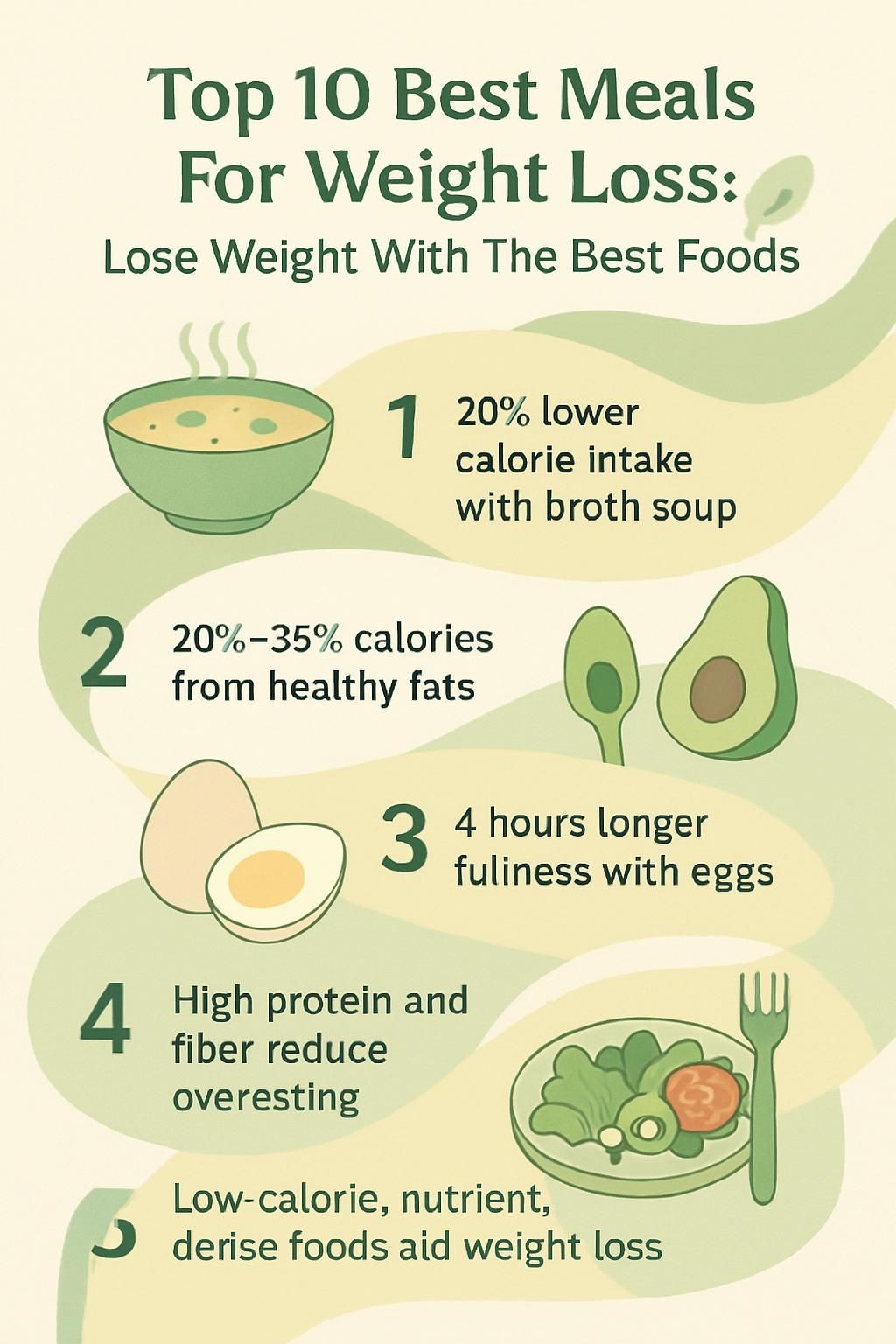
Benefits of Eating Healthy Meals for Weight Loss
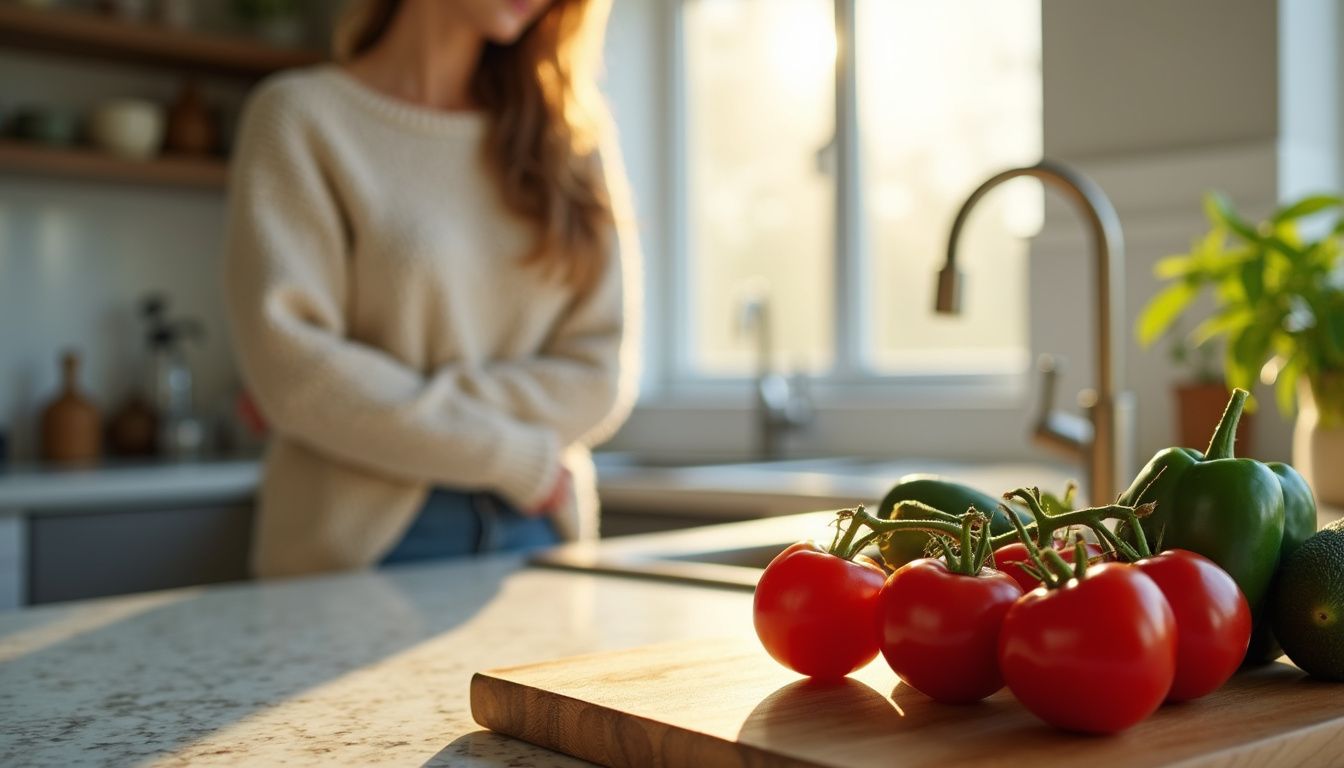
Healthy eating supports your weight loss journey and helps you reach a healthy weight. Nutritious meals make calorie control easier and help with long-term weight management.
How do healthy meals promote sustainable weight loss?
Healthy meals help you lose excess weight and keep it off. Plates filled with vegetables, fruits, lean proteins like fish or chicken, nuts, seeds, and whole grains tend to have fewer calories than fried or sugary foods.
Fiber from beans and leafy greens, plus protein from yogurt or eggs, boosts fullness and prevents overeating. These nutrients slow digestion, which keeps hunger in check.
Research shows that having a broth-based vegetable soup before lunch can reduce calories at the meal by about 20 percent. Leafy greens also contain thylakoids, a natural plant compound, which may support fullness during weight loss.
Choosing low glycemic index foods, such as cauliflower, helps manage blood sugar better than starchy options like white potatoes. That steadier blood sugar makes sustainable weight loss more likely.
Focusing on nutrient-rich foods makes losing body fat more manageable while supporting your energy and health.
You might wonder why some meals keep you full for hours even if they are low in calories.
Why do healthy meals keep you feeling full longer?
High-protein foods, like chicken breast, promote satisfaction because protein takes longer to digest. One serving has about 27 grams of protein with less than 150 calories, which supports fullness during a calorie deficit.
Oatmeal with walnuts is also great for satiety. A cup of oatmeal offers about 4 grams of fiber, and walnuts add more fiber and some protein.
Dietary fiber bulks up meals and slows how fast your stomach empties. Beans, legumes, apples, and whole grains are ideal if you want to lose weight on a healthy diet plan.
In studies, eggs at breakfast reduced calorie intake later in the day compared with cereal-based breakfasts. In a 2020 trial of fifty adults, eggs with toast increased fullness for four hours longer than cereal with milk and juice.
High-protein snacks, such as Greek yogurt or nuts, work better than many processed snacks to keep hunger away between meals.
What essential nutrients support overall health during weight loss?
Your body needs protein, fiber, healthy fats, vitamins, and minerals during weight loss. Protein helps you maintain muscle while burning fat. Greek yogurt supplies high-quality protein and may support digestion through helpful bacteria called probiotics.
Salmon provides about 17 grams of protein in a 3-ounce serving plus omega-3 fats that reduce inflammation. Sweet potatoes deliver complex carbohydrates and around 4 grams of fiber per medium potato. Both support steady energy and control hunger.
Iron from lean steak helps energy production, while vitamin C from broccoli improves iron absorption. Avocados deliver unsaturated fats and potassium that help manage blood pressure.
Chia seeds supply plant-based omega-3 fats and have been linked to greater fullness in small studies. Whole grains like oats or brown rice offer more fiber and protein than refined grains, which improves satiety and metabolic health.
Choosing high-fiber foods rich in nutrients sets you up for success. It also leads naturally into high-protein and high-fiber foods for weight loss-friendly meals.
How to Choose Weight Loss-Friendly Meals
Choosing the best foods for weight loss helps you manage portion size and calories. These meals support healthy eating habits and a balanced diet that fits daily life.
Which high-protein and high-fiber foods support weight loss?
High-protein and high-fiber foods help you feel full longer and support muscle health. They fit into almost any diet plan and make portion control easier.
- Skinless chicken breast offers about 27 grams of protein with less than 150 calories, which supports muscle during calorie restriction.
- Black beans, lentils, and chickpeas supply resistant starch, fiber, and plant-based protein. They work well in salads or as a main dish for a plant-forward plate.
- Greek yogurt is rich in protein and can be very filling, especially the full-fat version. It helps you stay satisfied between meals.
- Oatmeal contains about 4 grams of fiber per cup. Adding walnuts gives extra fiber and protein that fuel your morning.
- Eggs provide high-quality protein and healthy fats. Studies link them to increased satiety and less overeating later in the day.
- Pistachios are a lower-calorie nut option at about 160 calories per 50 nuts. They deliver fiber and protein that help control hunger.
- White beans add plant-based protein to grain bowls or soups and support steady blood sugar levels.
- Cottage cheese packs high-quality protein and calcium, which aid weight management and support lean mass during dieting.
- Salmon contains omega-3 fats and quality protein. It promotes fullness and protects heart health markers.
- Swapping a candy bar for Greek yogurt mixed with berries can cut afternoon cravings, which makes portion control easier in a weight loss plan.
What are low-calorie, nutrient-dense ingredients to include?
After you pick protein and fiber, choose ingredients that are low in calories but high in nutrients. These options boost vitamins and minerals without adding much energy.
- Leafy greens like spinach, kale, and collards are rich in fiber and vitamins yet low in calories. Use them as a salad base or to bulk up soups.
- Cauliflower has about 27 calories per cup and a low glycemic index. Try it mashed as a substitute for potatoes or rice.
- Broccoli provides about 65 percent of your daily vitamin C in half a cup. It pairs well with chicken or lean steak.
- Raspberries offer 4 grams of fiber per half cup plus many micronutrients. Add them to oatmeal for natural sweetness.
- Salsa adds flavor and vitamins with almost no calories. Spoon it over baked sweet potatoes or into whole-wheat tortillas with fish.
- Mushrooms deliver about 16 calories per cup. Replace part of the ground beef in a recipe with mushrooms to lower calories.
- Baked sweet potatoes have around 4 grams of fiber and about 112 calories each. Top with black beans for extra protein and fullness.
- Apples give natural sweetness and about 4 grams of fiber. Slice into salads or eat as a snack after exercise.
These ingredients make meals satisfying and rich in important nutrients, like protein, healthy fats, minerals, and natural fruit sugars. They also help you keep total calories lower for steady weight loss.
How much healthy fat should you include in weight loss meals?
Aim for healthy fats to make up 20% to 35% of daily calories. Include sources such as avocado, olive oil on roasted vegetables like cauliflower, and salmon for omega-3s.
Keep portions modest. One ounce of nuts, such as almonds or pistachios, offers unsaturated fat without too many calories. Full-fat Greek yogurt may improve satiety more than low-fat options.
When building high-protein, high-fiber meals, add small amounts of healthy fats instead of using low-fat processed foods. Drizzle a teaspoon of olive oil over salad or mix chia seeds into Greek yogurt for extra omega-3s.
Portion control matters because calorie-dense foods like avocado and nuts add up quickly. Use half an avocado or one tablespoon of nut butter per meal if you want to lose weight effectively.
Some people find a small square of dark chocolate with a few almonds offers satisfaction without blowing calorie goals, a practical approach used in plans like the Mayo Clinic Diet.
Avocado and Dark Leafy Greens Salad
An avocado and dark leafy greens salad is a simple way to add healthy fats, fiber, and vitamins. It supports weight loss while keeping your plate fresh and satisfying.
Why does avocado and leafy greens salad help with weight loss?
Avocado adds monounsaturated fat, a heart-healthy fat that increases satisfaction and slows hunger. Feeling full means you may eat fewer calories over the day and avoid weight cycling from short-term fad diets.
Leafy greens are packed with fiber that slows digestion, supports gut health, and adds volume with very few calories. This helps you stay within a calorie range that supports fat loss.
Avocado supplies potassium for healthy blood pressure. Its fat also helps your body absorb antioxidants from dark greens like spinach and kale. The mix is nutrient dense without the extra calories often found in processed foods.
Be mindful of portion size since avocados are energy dense. This simple salad fits easily into weekly routines and supports clear eating patterns.
What is a quick recipe for avocado and dark leafy greens salad?
Avocado and leafy greens are low in calories and high in nutrition. Use these simple steps for a fast, satisfying meal.
- Use fresh spinach or kale as the base for vitamins A, C, and K. Dark greens are nutrient dense and light in calories.
- Slice ½ an avocado per serving to add healthy fats that support fullness. Keep portions moderate.
- Chop bell peppers or cucumbers for extra fiber, crunch, and vitamin C. These add bulk with very few calories.
- Whisk one tablespoon of olive oil with fresh lemon juice. Drizzle to boost absorption of fat-soluble nutrients and add flavor.
- Sprinkle pumpkin or sunflower seeds, or a few chopped nuts like walnuts or almonds, for protein, crunch, and longer satisfaction.
- Toss gently just before serving to keep textures crisp and the flavors bright.
- This recipe takes under 10 minutes from start to finish, ideal for busy days.
Many runners enjoy this meal after a workout because it feels light but steady. You get a smart balance of protein, fiber, vitamins, and healthy fats that fits any weight loss plan.
Grilled Chicken with Cayenne Pepper and Steamed Vegetables
Grilled chicken with cayenne and steamed vegetables brings lean protein and bold flavor. The combo can help you stay on track without adding many calories.
How do lean protein and cayenne pepper boost metabolism?
Chicken breast provides about 27 grams of protein per serving, which supports muscle while you lose weight. Protein takes more energy to digest than carbs or fat, a process called the thermic effect of food.
This effect gives your metabolism a slight boost after a high-protein meal. Lean protein is also linked with better long-term weight management in reviews of clinical studies.
Cayenne pepper contains capsaicin, a natural compound that can increase calorie burning and reduce appetite. It adds flavor without heavy sauces or breaded coatings.
Using spices helps many people rely less on rich sauces and sides. That simple shift lowers calories while keeping meals satisfying.
What are simple tips for preparing grilled chicken and steamed vegetables?
Lean protein and fiber-rich vegetables create a balanced, low-calorie plate. Keep prep simple and consistent.
- Use skinless chicken breast to limit saturated fat while providing protein and iron.
- Season with cayenne, black pepper, and a pinch of salt. Cayenne may boost calorie burn after eating.
- Grill over medium-high heat for 5 to 7 minutes per side to lock in flavor without extra oil.
- Steam broccoli, carrots, or asparagus for 3 to 5 minutes until crisp-tender. Steaming preserves key nutrients.
- Finish with lemon juice or fresh herbs instead of creamy sauces to keep calories low.
- Prep vegetables ahead of time so assembly is quick after a workout or during an intermittent fasting window.
- Portion chicken to 3 to 4 ounces per serving to manage calories and support your goals.
Oatmeal with Walnuts and Fresh Berries
Oatmeal with walnuts and fresh berries delivers fiber, healthy fats, and antioxidants. It keeps you full and supports weight loss, especially as a steady breakfast.
What are the nutritional benefits of oatmeal with walnuts and berries?
A cup of cooked oats gives about 4 grams of fiber, which supports digestion and fullness. Walnuts add more fiber and heart-healthy fats that support cholesterol levels.
Raspberries contribute around 4 grams of fiber per half cup and bring antioxidants that protect cells. The mix balances whole grain carbs, healthy fat, and fruit so blood sugar rises more slowly.
You avoid added sugars because berries bring natural sweetness. This breakfast is nutrient dense yet modest in calories, which fits weight-loss plans or clinical programs after bariatric care.
Switching a sugary cereal for this bowl often extends fullness until lunch. That makes later meal choices easier and steadier.
How can you prepare oatmeal with walnuts and fresh berries?
This bowl is a smart breakfast or meal replacement. It is quick to make and simple to scale.
- Cook ½ to 1 cup of oats in water or milk for about 5 minutes, following the package directions.
- Stir in 2 tablespoons chopped walnuts to add crunch and healthy fats common in clinical meal plans.
- Top with ½ cup fresh raspberries for fiber and antioxidants linked to weight management.
- Sprinkle cinnamon for flavor without extra sugar.
- Adjust the portion to match your calorie targets so the meal fits your plan.
- Serve hot or chill it for later. Either way, it tends to keep you full longer than many high-sugar breakfasts.
- Prep in under 10 minutes and skip added sugars to keep it weight loss friendly.
- This approach works even on busy mornings before school runs or early meetings.
Salmon with Sweet Potato and Asparagus
Salmon with sweet potato and asparagus offers a balanced mix of protein, healthy fats, and complex carbs. It is a dinner that feels special yet supports your goals.
How do omega-3s and complex carbs aid weight loss in this meal?
Omega-3 fats from salmon can improve satiety and support fat metabolism. Studies link omega-3s with lower inflammation, better heart health, and improved appetite control.
A 3-ounce portion of salmon gives around 17 grams of protein, which protects muscle during weight loss. Sweet potatoes provide complex carbs with about 4 grams of fiber and roughly 112 calories per medium potato, which aids digestion and keeps hunger down.
These complex carbs deliver steady energy instead of spikes that lead to cravings. Asparagus adds extra fiber plus vitamins that help you stay nourished while losing weight.
Many people who swap white rice for roasted sweet potato feel more satisfied. That change can make calorie control much easier.
What is an easy way to cook salmon with sweet potato and asparagus?
Keep prep simple to stay consistent. This sheet-pan method saves time and dishes.
- Preheat the oven to 400°F so everything cooks evenly.
- Wash one medium sweet potato, pierce with a fork, and bake for 45 to 60 minutes until tender.
- Place a 3-ounce salmon fillet on a sheet pan. Season with lemon juice, pepper, and fresh dill or parsley for flavor without extra calories.
- Arrange trimmed asparagus next to the salmon. Drizzle with one teaspoon olive oil for healthy fats.
- Roast salmon and asparagus for 12 to 15 minutes. This preserves nutrients and keeps prep short.
- Slice the baked sweet potato and serve it under the salmon and asparagus for added fiber and color.
- Finish with fresh herbs. This boosts flavor while keeping sodium low.
- Adjust portions of salmon, sweet potato, and vegetables to match your calorie needs.
- Total time is under an hour with minimal hands-on work.
Bean and Vegetable Soup
Bean and vegetable soup is warm, filling, and low in calories. It is a helpful starter or a light meal on busy days.
Why is soup effective for portion control in weight loss?
Having a broth-based soup before your main dish can lower total calories at that meal by up to 20 percent. In one 2007 study, people felt fuller after a simple vegetable soup than when they skipped it.
Soup’s high water content adds volume without extra calories or fat. It also slows the pace of eating, which supports mindful portions. Broth-based soups tend to be lower in calories than creamy versions yet still feel satisfying.
Starting with hot soup can help you reach comfortable fullness sooner. It also makes skipping second helpings easier.
Which ingredients add flavor and nutrition to bean and vegetable soup?
Use a mix of beans, colorful vegetables, herbs, and a light broth. The result is hearty, tasty, and supportive of your plan.
- Add chickpeas or black beans for protein and fiber that keep you full longer.
- Mix in carrots, celery, spinach, and tomatoes to increase vitamins, minerals, and antioxidants.
- Season with garlic, thyme, or cumin for flavor without extra calories.
- Choose a vegetable broth or pureed tomato base to keep calories modest and saturated fat low.
- Stir in kale or Swiss chard in the final minutes for extra fiber and nutrients.
- Finish with a teaspoon of olive oil. Healthy fats aid vitamin absorption and satiety.
- Add whole grains like barley or farro for more fiber and steady energy.
- Skip creamy sauces or heavy cheese to avoid extra calories that slow progress.
Each ingredient raises nutrition while keeping the soup aligned with a balanced weight loss plan.
Greek Yogurt with Raspberries and Chia Seeds
Greek yogurt with raspberries and chia seeds is a high-protein, high-fiber snack. It helps control appetite between meals.
How does this high-protein snack help control appetite?
Protein from Greek yogurt slows digestion, which helps you feel full longer. In a small 2017 study, people who ate chia seeds with yogurt felt fuller and ate fewer calories at lunch.
Raspberry fiber adds bulk with very few calories. Chia seeds absorb liquid and thicken the mix, which increases fullness. Together, protein and fiber help stabilize blood sugar and curb cravings.
Full-fat Greek yogurt may keep you satisfied longer than low-fat varieties. Calcium in yogurt also supports bone health while you lose weight.
How can you customize Greek yogurt with raspberries and chia seeds?
This snack is easy to tailor to your taste and calorie goals. Keep the base simple, then add texture and flavor.
- Start with 1 cup plain, unsweetened Greek yogurt for maximum protein and minimal sugar.
- Add ½ cup fresh raspberries for fiber, vitamin C, and antioxidants.
- Stir in 1 tablespoon chia seeds to provide omega-3 fats and thick texture.
- Sweeten lightly with 1 teaspoon honey or a sprinkle of cinnamon if you prefer.
- Top with a few chopped nuts, like almonds or walnuts, for crunch and satiety.
- Layer ingredients in a clear jar for a quick parfait you can enjoy anywhere.
- Make portions ahead in small containers for a grab-and-go option.
- Adjust serving size to align with your daily calorie targets.
- Swap raspberries with blueberries or strawberries for variety without many extra calories.
This method keeps your snack balanced, portable, and satisfying.
Stir-Fried Mushrooms and Lean Ground Beef
Stir-fried mushrooms with lean ground beef creates a filling plate that is rich in protein and still modest in calories.
Why is stir-fried mushrooms with lean ground beef a good low-calorie option?
This combo delivers a high-protein meal while trimming calories. Mushrooms have about 16 calories per cup, and replacing half the meat with mushrooms can cut total calories in the dish.
Lean ground beef provides protein and iron with less saturated fat than higher-fat beef. The mushroom fiber adds volume so the portion looks and feels bigger without more calories.
Cooking with minimal oil keeps the dish lighter. The result supports weight management and tastes savory and satisfying.
What is a quick cooking process for this stir-fry?
One skillet and a few steps make this an easy weeknight dinner.
- Heat a skillet over medium heat and add 3 to 4 ounces of lean ground beef per serving.
- Brown the beef for 3 to 4 minutes, stirring until no pink remains.
- Add sliced mushrooms, using at least an equal volume to the beef.
- Add a teaspoon of olive oil only if the mixture begins to stick.
- Season with garlic, black pepper, and herbs for flavor without extra sodium.
- Cook 7 to 10 minutes until mushrooms soften and the mixture is cooked through.
- Serve with steamed vegetables or over brown rice for extra fiber.
- Adjust seasonings to taste, and keep sauces light to stay within calorie goals.
This method keeps cleanup easy and helps you meet calorie targets while feeling full through the evening.
Baked Sweet Potato Stuffed with Black Beans and Salsa
A baked sweet potato stuffed with black beans and salsa brings fiber, protein, and bold flavor. It is a simple, budget-friendly meal.
How does this meal balance protein, fiber, and flavor?
A medium sweet potato has about 4 grams of fiber and roughly 112 calories, which supports fullness. Black beans add plant-based protein and more fiber, both of which improve satiety and keep your energy steady.
Salsa adds vitamins A and C and bright taste with minimal calories. Together they create a nutrient-dense plate with resistant starch from sweet potato that supports digestive health.
The mix also stays low in saturated fat. In practice, this combo can help reduce mid-day hunger while keeping meals enjoyable.
What are quick assembly tips for baked sweet potato with black beans?
Shortcuts make this meal easy to stick with during a busy week.
- Bake sweet potatoes at 400°F for 45 to 60 minutes, or microwave for 7 to 10 minutes to save time.
- Warm black beans on the stove or in the microwave. Use ½ cup per serving.
- Split the potato lengthwise and fluff the inside with a fork.
- Top with warm black beans for even heating and better texture.
- Add 2 to 3 tablespoons of salsa for flavor without many calories.
- Use a spoon of plain Greek yogurt for extra protein and creaminess instead of sour cream.
- Finish with fresh cilantro or a squeeze of lime for brightness.
- Prep ingredients in advance so assembly takes only a few minutes.
- Serve at once to keep the texture and temperature just right.
Next, see how pairing broccoli with grilled steak creates a filling bowl that supports your plan.
Broccoli and Grilled Steak Bowl
Broccoli with grilled steak makes a hearty bowl packed with protein and fiber. It is satisfying without feeling heavy.
What are the benefits of combining cruciferous vegetables with lean protein?
Cruciferous vegetables, like broccoli, pair well with lean protein, such as grilled steak, to support weight loss. Half a cup of broccoli gives about 65% of your daily vitamin C, which helps your body absorb the iron in steak.
Lean steak delivers complete protein and iron that support muscle and metabolism during calorie restriction. Broccoli is low in calories yet high in fiber, so the bowl is filling without a big calorie load.
This combo also increases antioxidants from broccoli’s phytochemicals. Choosing lean cuts reduces saturated fat while preserving important nutrients.
Many people find this bowl keeps them full longer than meals with fewer vegetables or less protein. That steady energy supports better choices for the rest of the day.
How can you enhance a broccoli and grilled steak bowl?
Small touches raise the flavor and nutrition while keeping calories in check.
- Grill lean steak in 3 to 4 ounce portions to get protein with less saturated fat.
- Steam or roast broccoli until just tender to preserve texture and vitamin C.
- Squeeze fresh lemon over the bowl to add flavor and improve iron absorption.
- Add a scoop of brown rice or quinoa for extra fiber and steady energy.
- Finish with chopped herbs or a light vinaigrette to boost freshness without much sodium.
- Control portions by dividing steak and broccoli evenly in each bowl.
- Mix in bell peppers for color, crunch, and vitamins A and C.
- Assemble everything in one bowl for easy meal prep and portion control.
Green Tea with Lemon and a Handful of Almonds
Green tea with lemon plus a handful of almonds manages appetite and adds a gentle lift. It is a portable snack for busy days.
What weight loss benefits does green tea with lemon and almonds provide?
Green tea provides catechins, a group of antioxidants, that can nudge your metabolism and increase calorie burn. Drinking several cups a day has been linked with lower blood pressure and better weight control in research.
Lemon helps your body absorb the tea’s antioxidants more efficiently. Almonds offer protein and healthy fats that curb hunger and stabilize blood sugar, which reduces cravings.
This snack is easy to carry and helps you stay consistent when your schedule is tight.
When is the best time to enjoy this snack for weight loss?
Have it between meals, such as mid-morning or mid-afternoon, to control hunger and avoid high-calorie snacks. Many people enjoy it before or after light exercise for a steady energy boost.
Pair it with breakfast to get a gentle metabolism bump from the tea. Choose it as a light evening bite if late-night eating is a challenge.
Use work breaks for this snack to keep energy steady instead of reaching for sweets. Practice mindful eating to increase satisfaction and support your goals.
Whole-Wheat Tortilla with Fish and Fresh Salsa
A whole-wheat tortilla with fish and fresh salsa is quick to make and packed with whole grains, lean protein, and healthy fats.
How do healthy fats and whole grains support energy in this meal?
Whole grains in the tortilla provide complex carbs and fiber. They help keep blood sugar steady and prevent energy crashes later in the day.
Healthy fats from fish improve fullness and aid nutrient absorption from the salsa and vegetables. Lean fish also provides protein that supports muscle while helping you feel satisfied.
This balanced meal is rich in nutrients and modest in saturated fat, which supports several hours of steady energy.
What is a simple recipe for a whole-wheat tortilla with fish and salsa?
Fish tacos on whole-wheat tortillas make a fast, balanced meal. You get fiber, lean protein, and bright flavor in under 20 minutes.
- Preheat the oven to 400°F or set a skillet to medium heat.
- Choose a lean white fish, such as cod, about 4 ounces per taco.
- Season with black pepper, garlic powder, and a pinch of salt.
- Bake or grill for 8 to 10 minutes until the fish flakes with a fork.
- Warm whole-wheat tortillas in a dry skillet for 30 seconds per side.
- Spoon the fish onto each tortilla. Use about 4 ounces per serving.
- Top with fresh salsa made from diced tomatoes, onion, jalapeño, cilantro, and lime juice.
- Add shredded lettuce or a few avocado cubes if you want more nutrients and fullness.
- Serve while the tortillas are warm and the salsa is bright and fresh.
This meal is easy to adapt with what you have on hand. It keeps you energized and satisfied without feeling heavy.
Tips for Preparing Weight-Loss Meals Effectively
Small systems make healthy cooking faster. Use structure to support your plan on the toughest days.
How can portion control techniques improve your weight-loss meals?
Portion control helps you regulate calories, which improves results. Use practical steps to make meals satisfying without going over your targets.
- Measure serving sizes with a scale or measuring cups to avoid unplanned extras.
- Use smaller plates and bowls so portions look larger, which can reduce intake.
- Prioritize protein at each meal because it promotes fullness and tames appetite.
- Choose high-fiber foods like beans, vegetables, and whole grains for volume with fewer calories.
- Slow down at meals and set your fork down between bites. This mindful step can reduce calories by about 10 percent in studies.
- Prep meals in advance using containers so portions are set before hunger strikes.
- Choose grilling, roasting, or steaming instead of frying to limit added fats.
- Fill half your plate with colorful fruits and vegetables to increase satisfaction without raising total calories.
- Avoid processed items high in added sugars or unhealthy fats, which make portion control harder.
These tactics make it easier to eat less without feeling deprived. They support weight management and raise the impact of any weight loss plan.
Why is meal planning important for weight loss success?
Meal planning helps you make better choices and manage portions. It lets you include high-protein foods that boost fullness and protect muscle.
Planning also builds nutrient-rich combinations that keep you satisfied while maintaining a calorie deficit. Structured prep supports mindful eating and leads to flavorful, healthier recipes that fit your routine.
What processed ingredients should you avoid when preparing meals?
Processed ingredients can slow progress and affect your health. Choose whole foods more often to feel better each day.
- Skip sugary drinks like soda and sweet teas. They add calories without nutrients.
- Avoid processed meats such as bacon, sausage, and many deli slices. They often contain added sodium and preservatives.
- Cut out white bread and pastries made with refined flour. They spike blood sugar and do not keep you full.
- Limit chips and packaged snacks with artificial flavors or trans fats. These foods lack fiber and key nutrients.
- Watch canned soups high in sodium or flavor enhancers. Excess salt can lead to water retention.
- Avoid spreads with hydrogenated oils or trans fats. These fats can raise cholesterol.
- Check bottled salad dressings for added sugars and poor-quality oils. Make simple dressings at home.
- Be cautious with frozen meals labeled “diet” or “low calorie,” which may hide sugars, excess salt, or additives.
Swapping flavored yogurt for plain Greek yogurt with berries at breakfast can extend fullness and steady energy. Small changes like this add up across the week.
Conclusion
Choosing the best meals for weight loss helps you reach goals while enjoying flavorful food. The meals in this guide use balanced nutrition to support satiety and steady energy.
Cooking these dishes helps you control portions, raise protein and fiber, and keep blood sugar steady through the day. Research shows that lean proteins, healthy fats, high-fiber vegetables, and whole grains improve fullness and calorie control.[1] If you have medical conditions or a history of disordered eating, speak with a healthcare professional before making major changes.
With consistent habits and nutrient-dense meals for weight loss, you can manage your weight more easily and feel better meal by meal.
…
[1] Rolls BJ et al., “Soup preloads in a variety of forms reduce meal energy intake,” Appetite (2007).
FAQs
1. What are the top 10 best meals for weight loss?
The top 10 best meals for weight loss include grilled chicken salad, baked salmon with steamed broccoli, turkey and vegetable stir-fry, lentil soup, Greek yogurt with berries, quinoa and black bean bowl, cottage cheese with sliced peaches, roasted chickpeas with spinach, egg white omelet with tomatoes and mushrooms, and oatmeal topped with walnuts. These options provide high protein or fiber content which can help you feel full longer. Studies show that eating more protein may support fat loss while preserving muscle mass [1].
2. How do these foods help people lose weight?
These foods are low in calories but rich in nutrients like vitamins and minerals. They offer a balance of lean proteins and complex carbohydrates which helps regulate blood sugar levels. High fiber content slows digestion so you stay satisfied after eating [2]. Research suggests that diets higher in whole grains and vegetables can lower overall calorie intake.
3. Can I eat these meals every day without getting bored?
Yes; variety is possible by changing spices or adding different vegetables to each meal plan. For example, swapping spinach for kale or using brown rice instead of quinoa keeps your diet interesting while maintaining nutritional value.
4. Is there scientific evidence supporting the effectiveness of these meals for losing weight?
Multiple studies confirm that balanced meals featuring lean meats such as poultry or fish along with legumes or whole grains promote healthy body composition [3]. In my own experience following this approach led to steady progress over several months without feeling deprived.
Summary: Choosing nutrient-dense foods like those listed above supports sustainable fat reduction by promoting fullness and providing essential nutrition according to current research findings.
References:
[1] Leidy HJ et al., “Higher Protein Intake Preserves Lean Mass,” American Journal of Clinical Nutrition.
[2] Slavin JL & Lloyd B., “Health Benefits of Fiber,” Nutrition Reviews.
[3] Mozaffarian D et al., “Changes in Diet Quality Affect Weight Change,” New England Journal of Medicine

